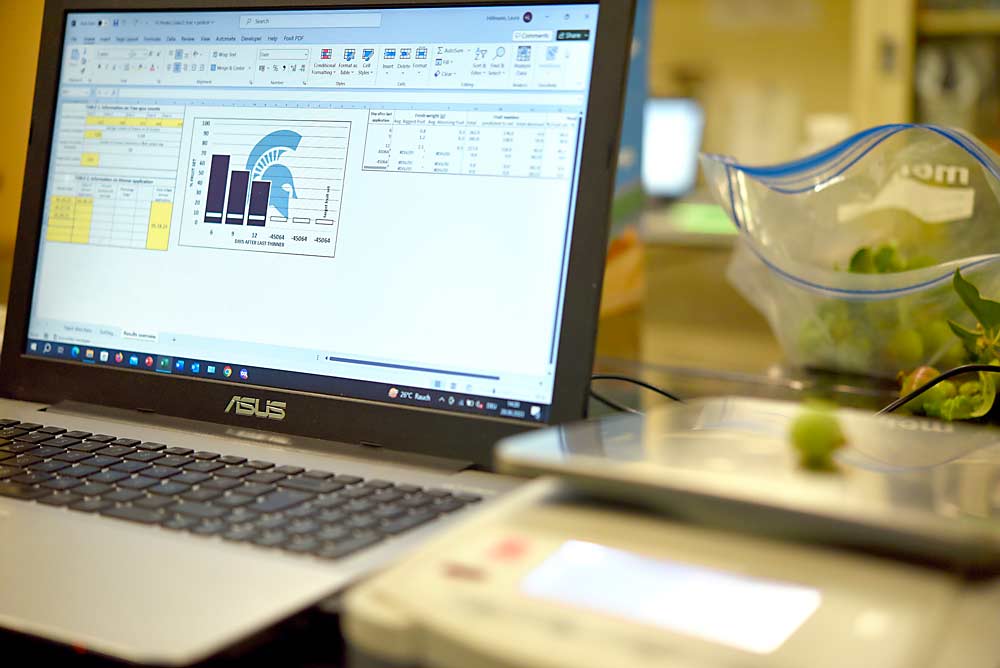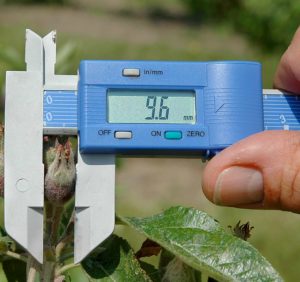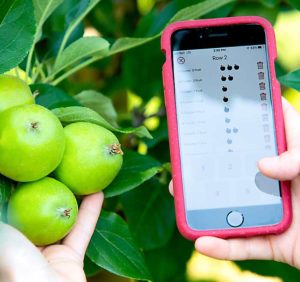
Goodbye, calipers.
For years, research and extension efforts have urged growers to implement precision crop load management models to improve thinning decisions, but most involve measuring the same fruitlets multiple times. A new tool promises to provide comparable data but saves time and effort by weighing random samples, rather than carefully making repeated measurements on marked fruitlets.
Called the Fruitlet Size Distribution (FSD) Model, the tool was developed by professor Todd Einhorn and graduate student Laura Hillmann at Michigan State University. Now available online at the Precision Apple Cropload Management website (pacman.extension.org), the model can be used by anyone.
The goal of FSD is to produce timely estimates of fruitlet abscission after thinner applications. Accurate predictions of fruit drop are crucial and help growers decide when to reapply chemical thinners — while they’re still efficacious — and avoid expensive hand thinning, Einhorn said.
The standard fruit growth rate model, first developed at the University of Massachusetts, measures the relative change in diameter of a given fruitlet over time. While precise, the approach requires multiple visits to the same tree, tagging or marking the same fruitlets, tracking their diameter with calipers over the course of one to two weeks, and recording all the data. It’s a tedious process that many growers haven’t adopted due to time constraints, he said.
FSD is faster, more convenient and has been just as accurate. The user collects random samples of fruitlets and weighs them on a scale to derive their size.
“The apple’s diameter-to-weight correlation is very strong and predictable,” Einhorn said. “A fruitlet’s weight can be precisely estimated from its diameter, taken from a caliper or image, and vice versa. It’s essentially a perfect fit.”
They recommend starting the sampling process after fruitlets have reached an average diameter of 6 millimeters. On each sample day, gather 40 clusters from various trees, weigh the fruitlets and repeat the process every two or three days for a total of four or five sampling days, Hillmann said.
The scale, connected to a laptop, automatically exports the fruitlet weights to a macro-embedded Excel file, saving time on data entry. Once filled out, the file generates predictions for which fruitlets will abscise by comparing their size to the most rapidly growing or largest fruitlet within the sample date, she said.
This scale-based approach can fit well with the emerging camera-based crop load management technologies marketed to the tree fruit industry. Imaging systems need to be calibrated, and FSD’s random sampling approach renders georeferencing of fruit unnecessary, Einhorn said. This could potentially reduce the cost when using image-driven models to derive fruit set predictions.
FSD’s sampling process also renders the sampled fruit unharvestable, but taking small samples during the thinning period doesn’t affect overall yields, Hillmann said.
Einhorn’s team started work on FSD a few years ago and intensified its efforts as part of the Precision Apple Cropload Management project — a nationwide effort to improve precision crop load management. The FSD project has received funding from the U.S. Department of Agriculture, MSU and the Michigan Apple Committee.
FSD trial results from Michigan, New York, North Carolina and Washington state have been consistent. Einhorn and fellow researchers will continue to improve the tool’s user-friendliness and precision, he said.
New York growers Jill MacKenzie and her husband, Mark Russell, tried the FSD model for the first time in spring 2023. They had been using Cornell University’s Malusim app to aid thinning decisions for a few years, but they found the process cumbersome and labor-intensive. Russell had to stand on a ladder for hours at a time measuring fruitlets, and “silly difficulties” like sun glare on the screen of the digital calipers or spotty phone connectivity in the orchard made it harder to record data, MacKenzie said.
One of the advantages of FSD is its simplicity: You can train any worker to collect samples, put them on a scale and push print — as opposed to walking around an orchard trying to find tagged trees. There’s still some time and labor involved with FSD, however. The fruitlet samples can be gathered fairly quickly, but cleaning, separating and weighing each fruitlet can be time-consuming, she said.
MacKenzie said 2023 probably wasn’t the best year to test the efficacy of the FSD model, because fruit set was so strong.
“All the fruit is sticking, and the model is showing that,” she said in June. “It’s clear to me and the model that the fruit is not falling off.”
—by Matt Milkovich








Leave A Comment